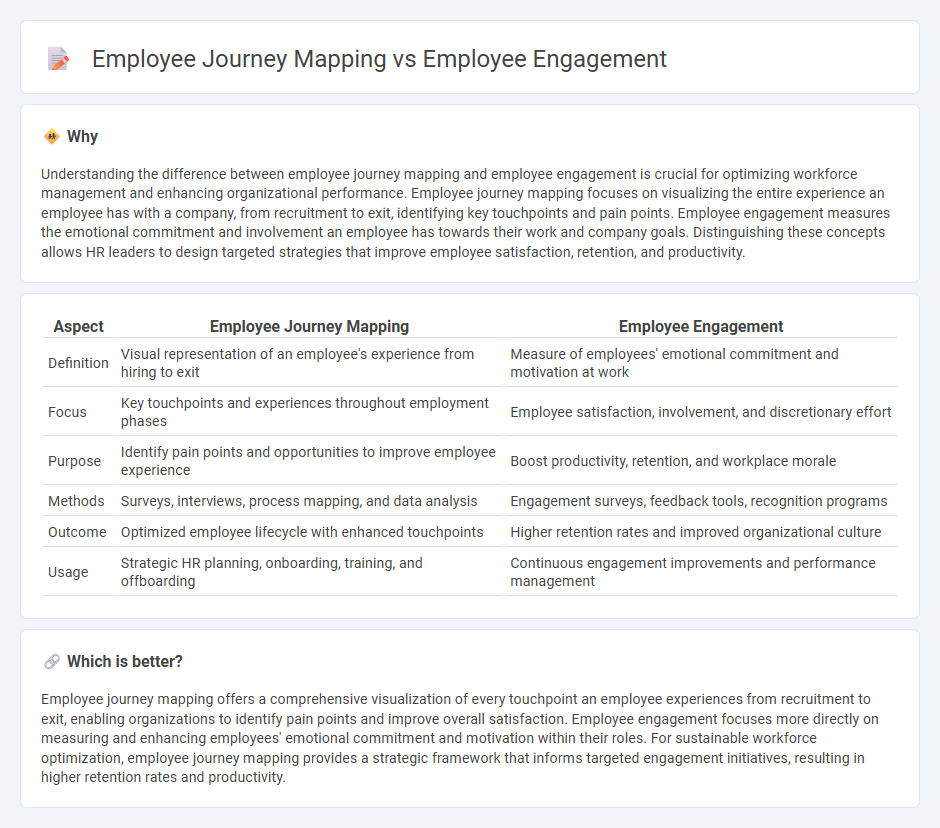
Employee journey mapping provides a detailed visualization of each touchpoint an employee experiences within an organization, focusing on improving processes and satisfaction. Employee engagement measures the emotional commitment and motivation of employees towards their work and company goals, influencing productivity and retention. Explore how integrating journey mapping with engagement strategies can transform workforce management.
Why it is important
Understanding the difference between employee journey mapping and employee engagement is crucial for optimizing workforce management and enhancing organizational performance. Employee journey mapping focuses on visualizing the entire experience an employee has with a company, from recruitment to exit, identifying key touchpoints and pain points. Employee engagement measures the emotional commitment and involvement an employee has towards their work and company goals. Distinguishing these concepts allows HR leaders to design targeted strategies that improve employee satisfaction, retention, and productivity.
Comparison Table
| Aspect | Employee Journey Mapping | Employee Engagement |
|---|---|---|
| Definition | Visual representation of an employee's experience from hiring to exit | Measure of employees' emotional commitment and motivation at work |
| Focus | Key touchpoints and experiences throughout employment phases | Employee satisfaction, involvement, and discretionary effort |
| Purpose | Identify pain points and opportunities to improve employee experience | Boost productivity, retention, and workplace morale |
| Methods | Surveys, interviews, process mapping, and data analysis | Engagement surveys, feedback tools, recognition programs |
| Outcome | Optimized employee lifecycle with enhanced touchpoints | Higher retention rates and improved organizational culture |
| Usage | Strategic HR planning, onboarding, training, and offboarding | Continuous engagement improvements and performance management |
Which is better?
Employee journey mapping offers a comprehensive visualization of every touchpoint an employee experiences from recruitment to exit, enabling organizations to identify pain points and improve overall satisfaction. Employee engagement focuses more directly on measuring and enhancing employees' emotional commitment and motivation within their roles. For sustainable workforce optimization, employee journey mapping provides a strategic framework that informs targeted engagement initiatives, resulting in higher retention rates and productivity.
Connection
Employee journey mapping identifies key touchpoints and experiences throughout the employee lifecycle, which helps organizations address pain points and enhance overall satisfaction. Improving these targeted moments increases employee engagement by fostering a supportive and motivating work environment. Enhanced engagement leads to higher productivity, retention, and a stronger organizational culture aligned with business goals.
Key Terms
**Employee Engagement:**
Employee engagement measures an employee's emotional commitment and motivation towards their work and organization, directly impacting productivity and retention rates. It involves assessing factors such as job satisfaction, recognition, and communication effectiveness to create a motivated workforce. Discover how companies leverage employee engagement strategies to enhance overall organizational performance.
Motivation
Employee engagement centers on understanding and enhancing employees' motivation and commitment through surveys, feedback, and recognition programs. Employee journey mapping identifies key touchpoints in an employee's experience to uncover motivational drivers and barriers affecting their satisfaction and productivity. Explore how integrating both approaches can create a comprehensive strategy to boost motivation across the workforce.
Recognition
Employee engagement centers on fostering employee motivation and satisfaction through consistent recognition programs that highlight individual and team achievements. Employee journey mapping focuses on pinpointing key moments in the employee lifecycle where recognition can have the greatest impact, such as onboarding, project completions, and performance reviews. Explore how integrating recognition into both strategies can elevate workplace culture and drive retention.
Source and External Links
Why employee engagement is key to company success - Firstup - Employee engagement leads to higher productivity, profitability, and retention by making employees feel valued, connected, and recognized through personalized communication and feedback.
How to Improve Employee Engagement in the Workplace - Gallup.com - Engaged employees drive better business results--including increased productivity, customer loyalty, and wellbeing--while reducing absenteeism, turnover, and safety incidents across all industries and company sizes.
What is Employee Engagement? (And How to Boost It) - Quantum Workplace - Employee engagement boosts productivity, retention, customer satisfaction, and workplace safety by fostering a sense of value, involvement, and connection between employees and their organization.
 dowidth.com
dowidth.com